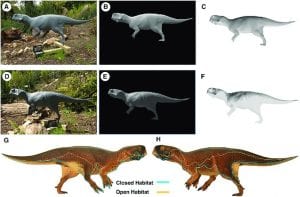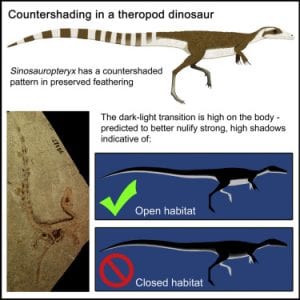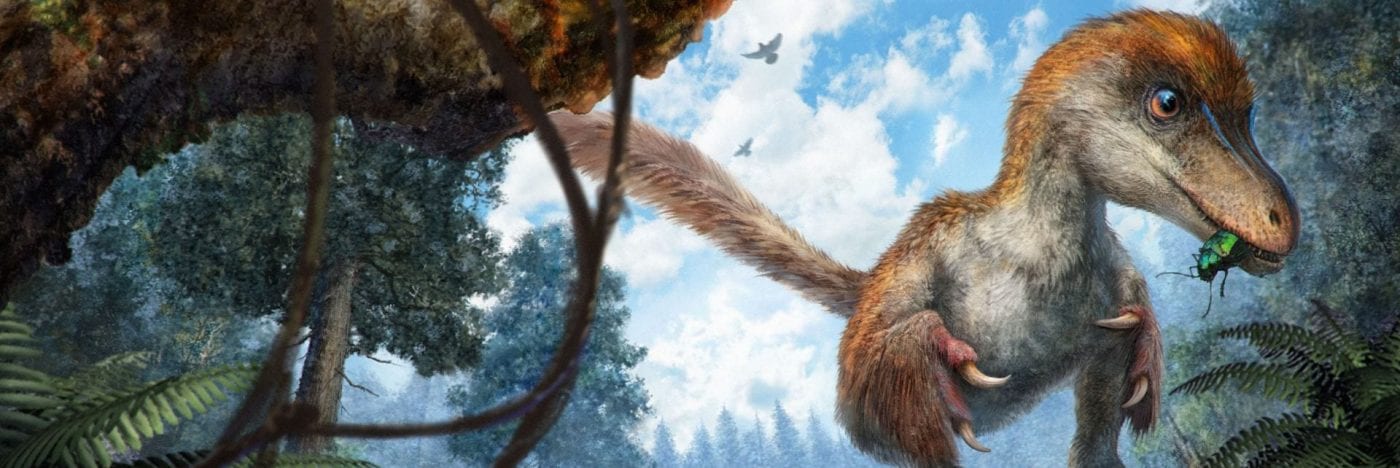 Psittacosaurus countershading
Psittacosaurus countershading
Modern animals use countershading as a form of camouflage. Commonly, a land animal may have a pale belly and coloured back. Countershading has been identified in to dinosaurs, Psittacosaurus and Sinosauropteryx.
In the first study, Vinther et al. (2016) noted the pale belly and darker sides and back in Psittacosaurus (right). Colour patterns could be seen in the exceptionally preserved specimen in the Senckenberg Museum, Frankfurt Germany. This specimen, originally from China, shows the scales all over the body and the strange cornified bristles along the midline of the back. The scales show clear countershading, giving the dinosaur a light underbelly and tail, and a pigmented chest region. Other patterns resemble disruptive cam-ouflage, whereas the chin and jugal bosses on the face appear dark.
[Right] Drawings of a model of Psittacosaurus made by Bob Nicholls (Palaeocreations, Bristol).
[Below] Testing Psittacosaurus countershading in natural conditions. (A–F) Grey-coloured cast without bristles attached, shown in “closed habitat” conditions (A–C) and direct illumination (D–F). The model is shown as if in its natural environment (A and D), masked (B and E), and in inverse colour (C and F). (G and H) Predicted boundaries of the countershading transition if Psittacosaurus lived in closed (blue) or open (yellow) habitats – its observed pattern matches the ‘closed’ habitat prediction.
 In modern animals, especially plant-eating animals such as deer and antelope, the dark back and pale belly counteract the gradient created by bright sunlight from above, and making the animal seem flat. Predators then struggle to see the animal standing there, but what they see is a 2D image, which is uniform and grey in colour. Studies of modern African savannah animals show that the degree of countershading varies with the average amount of sunlight. In open habitats, where direct overhead sunshine dominates, there is a sharp dark-light colour transition high on the side of the body; in closed habitats (for example in a forest), diffuse light dominates and there is a smoother gradation from light to dark on the side of the camouflaged animal. In the case of Psittacosaurus, its low-placed light-dark transition suggests it lived in wooded habitats.
In modern animals, especially plant-eating animals such as deer and antelope, the dark back and pale belly counteract the gradient created by bright sunlight from above, and making the animal seem flat. Predators then struggle to see the animal standing there, but what they see is a 2D image, which is uniform and grey in colour. Studies of modern African savannah animals show that the degree of countershading varies with the average amount of sunlight. In open habitats, where direct overhead sunshine dominates, there is a sharp dark-light colour transition high on the side of the body; in closed habitats (for example in a forest), diffuse light dominates and there is a smoother gradation from light to dark on the side of the camouflaged animal. In the case of Psittacosaurus, its low-placed light-dark transition suggests it lived in wooded habitats.
Sinosauropteryx countershading

In a second study, Smithwick et al. (2017) turned their attention to Sinosauropteryx, the small compsognathid theropod that had simple bristle-like feathers, and ginger and white feathers in stripes down its tail. These colour patterns had been established earlier (Zhang et al. 2010) by examining melanosomes in the feathers. The new work concentrated on the distribution of light and dark shades over the face and body.
Smithwick et al. (2017) reported that the light belly-dark back transition occurred higher up the side of Sinosauropteryx than in Psittacosaurus, and so the little predator was better adapted for life in the open than its plant-eating contemporary. Sinosauropteryx also shows a “bandit mask,” consisting of a band of ginger-coloured feathers running from around the eyes and back to the neck. This pattern is seen in many living vertebrates, particularly birds, where it serves multiple functions including camouflage. Sinosauropteryx therefore shows multiple colour pattern features likely related to the habitat in which it lived.
These two studies of animals that lived in the same place at the same time begins to show the kind of habitat differentiation we see today. Psittacosaurus was adapted to live more in wooded areas, whereas Sinosauropteryx shows evidence for life spent more out in the open.
References
- Smithwick, F.M., Nicholls, R., Cuthill, I.C., and Vinther, J. 2017. Countershading and stripes in the theropod dinosaur Sinosauropteryx reveal heterogeneous habitats in the Early Cretaceous Jehol Biota. Current Biology 27, 3337–3343.
- Vinther, J., Nicholls, R, Lautenschlager, S., Pittman, M., Kaye, T.G., Rayfield, E., Mayr, G. and Cuthill, I.C. 2016. 3D camouflage in an ornithischian dinosaur. Current Biology 26, 2456–2462.
- Zhang, F., Kearns, S.L, Orr, P.J., Benton, M.J., Zhou, Z., Johnson, D., Xu, X., and Wang, X. 2010. Fossilized melanosomes and the colour of Cretaceous dinosaurs and birds. Nature 463, 1075-1078. Download the paper here and the Supplementary data.
Videos
- Jakob Vinther talks about his work on countershading in Psittacosaurus.
- Fiann Smithwick talks about his work on colour and countershading in Sinosauropteryx.
- The National Geographic take on colour in Sinosauropteryx – the dinosaur that looked like a racoon (?!)

